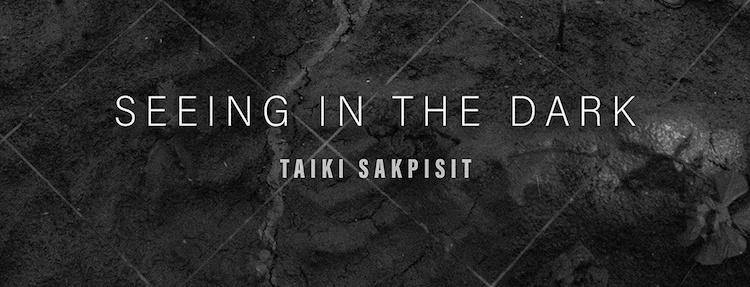A retrospective of short films by Taiki Sakpisit took place this evening at SAC Gallery in Bangkok, followed by a Q&A with the artist. Gallery Movie Night: A Night of Cinematic Exploration featured four of Taiki’s previous films — Shadow and Act, A Ripe Volcano, Seeing in the Dark, and The Age of Anxiety — and one new production, The Spirit Level. Like Apichatpong Weerasethakul’s A Minor History (ประวัติศาสตร์กระจ้อยร่อย), The Spirit Level tackles the tragic discoveries of the bodies of murdered political dissidents in the Mekong river.


Shadow and Act
Shadow and Act — like Sorayos Prapapan’s Prelude of the Moving Zoo and Anocha Suwichakornpong’s Come Here (ใจจำลอง) — features sequences shot at Dusit Zoo, which was closed by royal decree in 2018. Shadow and Act also includes shots filmed at another prestigious institution from a bygone age, the Chaya Jitrakorn photography studio, panning slowly around the studio’s fixtures and fittings, settling upon dusty portraits of Cold War dictator Phibun Songkhram and other kharatchakan (‘civil servants’).

A Ripe Volcano
Similarly, in A Ripe Volcano (ภูเขาไฟพิโรธ), the camera prowls elegiacally through the empty corridors of the Royal Hotel, another example of Bangkok’s faded glory. The hotel became a makeshift field hospital in 1992 during ‘Black May’, and its lobby was stormed by the military. A Ripe Volcano evokes the violence of the event through indirect signifiers, such as a fire engine (several of which were set ablaze in 1992), creating an uncanny sense of foreboding. Weerapat Sakolvaree’s Zombie Citizens and Thunska Pansittivorakul’s Homogeneous, Empty Time (สุญกาล) also evoke Black May with shots of the hotel.

Seeing in the Dark
Seeing in the Dark opens with contemplative, static images of Khao Kho, a mountainous region in northern Thailand with a potent political legacy: Phibun hid the country’s gold reserve — and the Emerald Buddha statue — from the Japanese there during World War II, and the area was a base for communist insurgents throughout the 1970s. There are shots of the Sacrificial Monument compound, which memorialises the ‘sacrifices’ of the soldiers who fought the communists, rather than the thousands of insurgents who were killed.
Thailand’s Ministry of Tourism website notes that Khao Kho was once “a red area smoldering in the smoke of war from different political ideologies. Khao Kho was considered a forbidden land that ordinary people should not get too close to because it was considered extremely dangerous. But as time passed, the conflict ended and Khao Kho transformed into one of Phetchabun’s most striking and beautiful tourist areas.”
A similar reputational whitewashing took place at other sites of anti-communist violence, such as Santikhiri and Nabua, a process examined in Thunska’s Santikhiri Sonata (สันติคีรี โซนาตา), Apichatpong’s A Letter to Uncle Boonmee (จดหมายถงลงบญม), and Pachara Piyasongsoot’s exhibition Anatomy of Silence (กายวิภาคของความเงียบ). Khao Kho, Santikhiri, and Nabua are, to use Dutch artist Armando’s term, ‘guilty landscapes’: tranquil spaces that bear silent witness to historical violence.
In Seeing in the Dark, an ominous rumble on the soundtrack hints at the continued presence of this past menace. The film ends with footage of anti-government protests from October 2020, a reminder — to quote the Ministry of Tourism again — that Thailand is still “smoldering in the smoke of war from different political ideologies.”
Thailand’s Ministry of Tourism website notes that Khao Kho was once “a red area smoldering in the smoke of war from different political ideologies. Khao Kho was considered a forbidden land that ordinary people should not get too close to because it was considered extremely dangerous. But as time passed, the conflict ended and Khao Kho transformed into one of Phetchabun’s most striking and beautiful tourist areas.”
A similar reputational whitewashing took place at other sites of anti-communist violence, such as Santikhiri and Nabua, a process examined in Thunska’s Santikhiri Sonata (สันติคีรี โซนาตา), Apichatpong’s A Letter to Uncle Boonmee (จดหมายถงลงบญม), and Pachara Piyasongsoot’s exhibition Anatomy of Silence (กายวิภาคของความเงียบ). Khao Kho, Santikhiri, and Nabua are, to use Dutch artist Armando’s term, ‘guilty landscapes’: tranquil spaces that bear silent witness to historical violence.
In Seeing in the Dark, an ominous rumble on the soundtrack hints at the continued presence of this past menace. The film ends with footage of anti-government protests from October 2020, a reminder — to quote the Ministry of Tourism again — that Thailand is still “smoldering in the smoke of war from different political ideologies.”

The Age of Anxiety
The retrospective concluded with The Age of Anxiety which, with its rapid-fire editing and screeching soundtrack, captured the anxious atmosphere during the twilight of King Rama IX’s reign. The film’s English title reflects the national mood while Rama IX was hospitalised, though its original Thai title (รอ ๑๐) added another interpretation. The film is also streaming on the Kortfilm website, which links it to Thai politics: “Made in response to the government’s merciless obliteration of the Red Shirt protesters in the 2010s, the music and flashing images are a reflection of a traumatized and anxious mental state.”

Dark Was the Night
Yesterday’s event was part of Taiki’s Dark Was the Night (ผีพุ่งไต้) exhibition, which opened on 9th May and runs until 6th July. The exhibition features a two-channel video installation, also titled Dark Was the Night, projected at opposite ends of the gallery. On one side are shots of the Thammasat University campus, which initially seem to contrast with the theme of the exhibition. But these images are metaphorically rather than literally dark, reminders of the 6th October 1976 massacre that took place at Thammasat, making the campus another ‘guilty landscape’. The exhibition also features three photographs from Taiki’s Thammasat University series, including an image of the notorious red lift in which sheltering students were shot during the massacre. The lift was also featured in the horror film Haunted Universities (มหาลัยสยองขวัญ).


